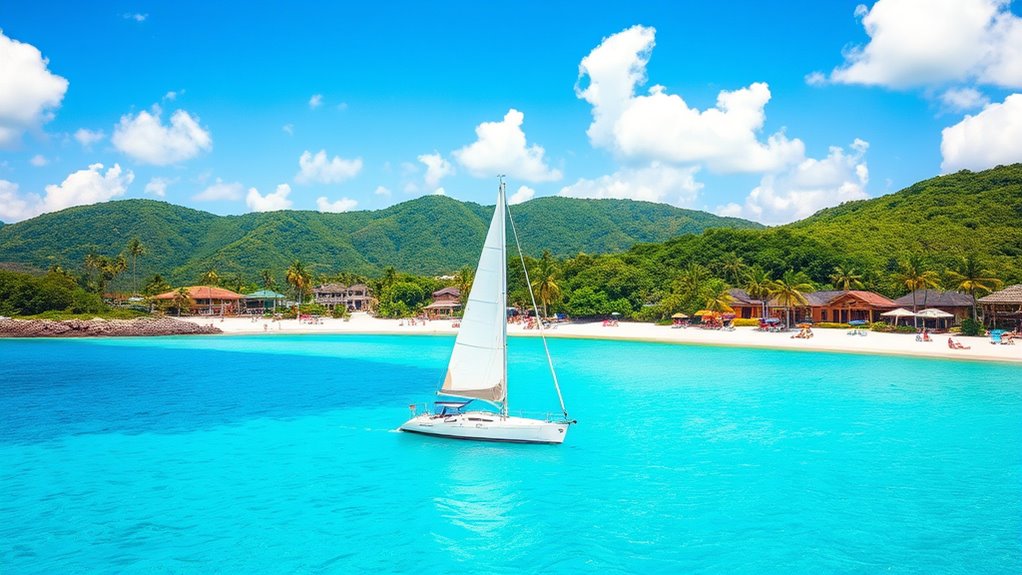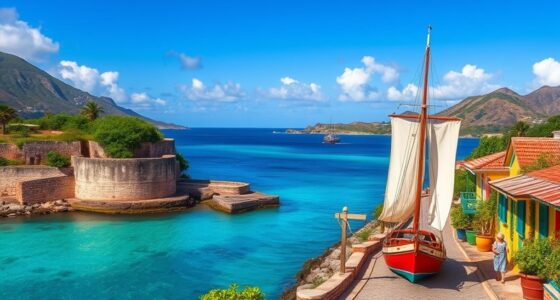Discover the ultimate travel experience in the U.S. Virgin Islands by exploring St. Thomas, St. John, and St. Croix, each offering unique beaches, culture, and history. Enjoy water activities like snorkeling, diving, and relaxing on pristine beaches, while exploring historic sites and scenic trails. Savor local cuisine and plan your trip around peak or off-peak seasons for great weather and savings. Keep exploring to uncover more tips for making your island adventure unforgettable.
Key Takeaways
- Overview of main islands (St. Thomas, St. John, St. Croix) and their unique attractions and facilities.
- Essential tips for exploring beaches, water activities, and marine conservation efforts.
- Best seasons to visit, considering weather, crowds, and hurricane risks.
- Cultural heritage highlights, including historic sites, festivals, and local cuisine.
- Transportation options, accommodations, and island-hopping tips for an enjoyable trip.
Exploring the Main Islands: St. Thomas, St. John, and St. Croix

Are you ready to discover the unique charms of each main island in the U.S. Virgin Islands? St. Thomas is your bustling gateway, famous for Charlotte Amalie, vibrant shopping, and lively beaches like Magens Bay. It’s perfect for those who enjoy lively atmospheres and cruise ship excitement. St. John offers a serene escape, with most of its land protected as national park, ideal for hiking, snorkeling, and immersing yourself in untouched nature. Its limited accommodations mean fewer crowds, making it a tranquil retreat. St. Croix is the largest island, less touristy, and rich in history. Explore its sugar plantation ruins, colorful towns like Christiansted, and beautiful beaches such as Cane Bay. Each island offers a distinct experience, ensuring a diverse and memorable trip. Many of these islands feature frost-free freezers in their accommodations and facilities, helping preserve food and maintain freshness during your stay.
Discovering the Rich Cultural Heritage and Historic Sites

The U.S. Virgin Islands boast a rich cultural heritage reflected in their historic sites and vibrant traditions. You can explore colonial towns like Christiansted and Frederiksted on St. Croix, where colorful buildings and preserved architecture tell stories of the islands’ Danish past. Visit sugar plantation ruins, around 150 on St. Croix, to see the remnants of the once-thriving sugar industry. On St. John, petroglyphs on Reef Bay Trail reveal native Caribbean influences. You’ll also find Blackbeard’s Castle on St. Thomas, a legendary site with panoramic views. Local festivals, music, and cuisine celebrate the islands’ diverse history. Walking through these sites immerses you in the islands’ unique blend of African, European, and Caribbean cultures, enriching your travel experience beyond the beaches. Exploring Halloween traditions in the islands can also provide insight into their rich cultural tapestry, especially during local celebrations and festivals.
Top Beaches and Water Activities for Relaxation and Adventure

With its turquoise waters and soft sandy shores, the U.S. Virgin Islands offer top beaches and water activities for both relaxation and adventure. On St. Thomas, Magens Bay is perfect for swimming and sunbathing, while Trunk Bay on St. John features a renowned underwater trail ideal for snorkeling. Cane Bay on St. Croix offers excellent diving spots for experienced snorkelers and divers. To ensure a safe and enjoyable experience, it’s helpful to review safety guidelines and familiarize yourself with local conditions before heading out.
Must-Visit Natural Attractions and Scenic Trails
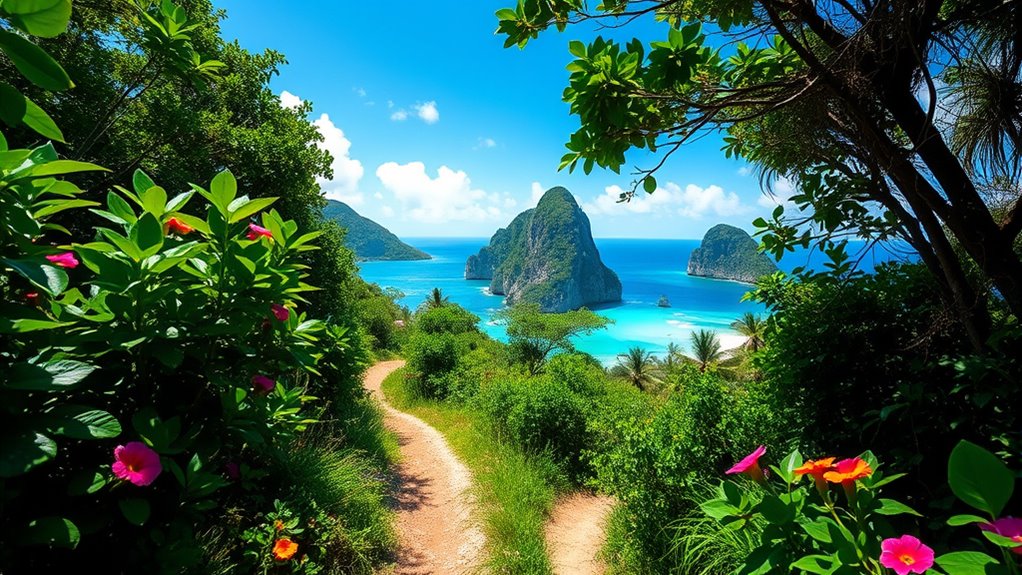
You’ll find incredible natural attractions and scenic trails across the islands that showcase their lush landscapes and vibrant ecosystems. The Reef Bay Trail on St. John offers a memorable hike through tropical forests with historic ruins along the way, while Buck Island Reef provides stunning underwater scenery for snorkeling. Don’t miss Trunk Bay, where the protected coral reefs and pristine shoreline create a perfect setting for exploring nature’s beauty. Additionally, engaging with local conservation efforts can enhance your understanding of the island’s efforts to preserve its unique biodiversity.
Reef Bay Trail
Nestled within the lush landscape of St. John, Reef Bay Trail offers an immersive hiking experience through tropical forests and historical sites. As you trek this well-maintained path, you’ll pass ancient petroglyphs, sugar mill ruins, and stunning vistas of the Caribbean Sea. The trail descends to Reef Bay Beach, where you can relax, snorkel, or explore vibrant coral reefs just offshore. Along the way, enjoy sightings of native wildlife and lush plant life that showcase the island’s rich biodiversity. The trail is accessible for most hikers and provides a perfect combination of adventure, history, and natural beauty. Be sure to bring water, sturdy shoes, and a camera to capture the scenic views and archaeological treasures along this memorable route. Additionally, understanding the local ecosystem enhances appreciation of the diverse flora and fauna encountered during your hike.
Buck Island Reef
Have you ever wondered where you can explore vibrant coral reefs and underwater ecosystems just offshore? Buck Island Reef is the perfect spot. Located off the coast of St. Croix, this protected marine park features a stunning underwater trail that makes snorkeling easy and exciting. You’ll see colorful corals, tropical fish, and even sea turtles gliding through crystal-clear waters. The island itself offers scenic hiking trails with panoramic views of the Caribbean Sea, perfect for nature lovers. Guided tours often include snorkeling gear and explanations about the reef’s diverse marine life and conservation efforts. Whether you’re an experienced diver or a beginner snorkeler, Buck Island Reef provides an unforgettable underwater adventure just a short boat ride from the main island. Additionally, understanding marine conservation can enrich your experience and appreciation for this fragile ecosystem.
Trunk Bay Nature
St. John’s Trunk Bay Nature offers an unforgettable experience for nature lovers. As you arrive, you’ll be captivated by the pristine white-sand beach and crystal-clear waters, perfect for swimming and snorkeling. The iconic underwater trail allows you to explore vibrant coral reefs teeming with marine life. Behind the beach, lush tropical trails wind through the island’s protected rainforest, showcasing native plants, birdlife, and scenic vistas. The well-maintained walking paths are ideal for a leisurely hike, offering panoramic views of the ocean and surrounding islands. Whether you’re seeking a peaceful spot to relax or an adventurous trail to explore, Trunk Bay Nature combines stunning scenery, rich biodiversity, and accessible trails, making it a must-visit for anyone wanting to connect with the Virgin Islands’ natural beauty. Additionally, the area’s biodiversity highlights the importance of conservation efforts to preserve these unique ecosystems for future generations.
Navigating Travel Options and Getting Around the Islands
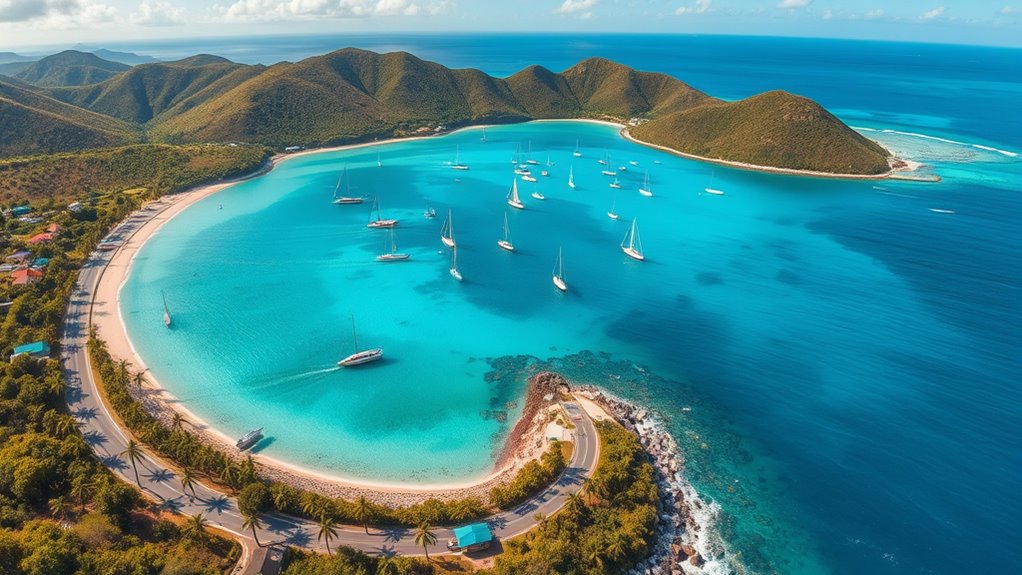
Getting around the U.S. Virgin Islands is straightforward once you know your options. Most travelers find renting a car, especially a jeep, the easiest way to explore at your own pace, since public transportation is limited. Ferries connect St. Thomas and St. John frequently, making island hopping simple; just check schedules to plan your day. St. Croix is more remote, with fewer ferry options, so a rental car or taxi is essential for exploring its sights. For longer distances or international arrivals, flights into Cyril E. King Airport (St. Thomas) and Henry E. Rohlsen Airport (St. Croix) are your best bet. Cruise ships primarily dock at St. Thomas, offering easy access to taxis and shuttles. Overall, having a vehicle gives you the freedom to discover hidden beaches and scenic routes. Ford Tuning can also be considered for vehicle optimization if you plan to upgrade your rental car for better performance.
Best Accommodation Choices for Every Budget
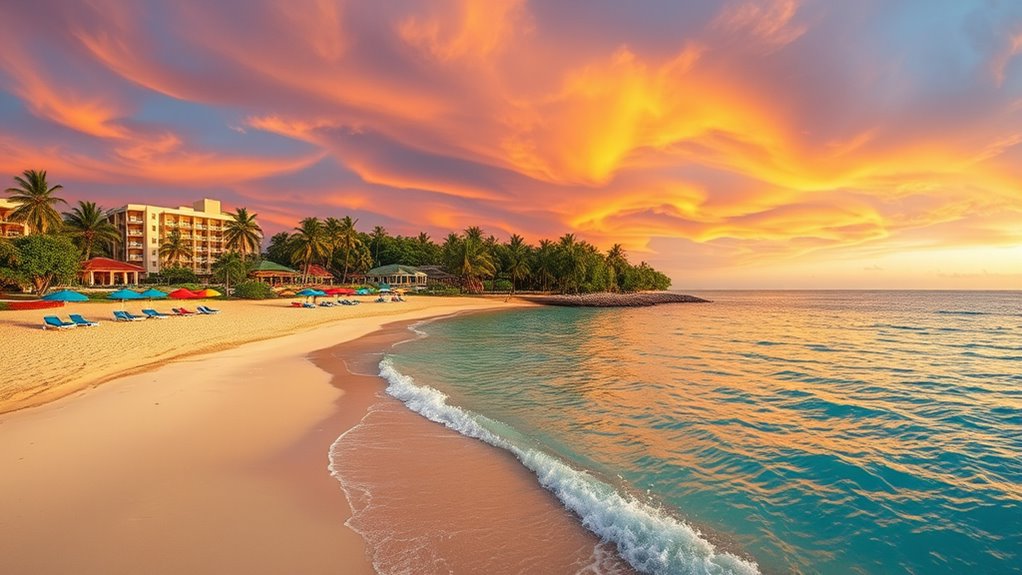
Whether you’re exploring the bustling streets of St. Thomas, St. John’s quiet beaches, or St. Croix’s rich history, you’ll find accommodation options for every budget. If you’re seeking luxury, opt for beachfront resorts or private villas on St. Thomas and St. Croix, offering top-tier amenities and stunning views. Budget travelers can enjoy charming hostels, inns, or affordable hotels, especially on St. Thomas, with easy access to major attractions. On St. John, consider eco-lodges or camping for a more intimate, nature-focused stay. For a truly local experience, vacation rentals and guesthouses provide comfort without breaking the bank. Incorporating a growth mindset can help you adapt to different accommodation options and make the most of your stay. No matter your budget, you’ll find a place that suits your style and enhances your island adventure.
Savoring Local Cuisine and Culinary Experiences

The U.S. Virgin Islands offer a vibrant culinary scene that reflects their Caribbean roots and colonial history. As you explore, you’ll savor dishes like fresh seafood—conch fritters, lobster, and grilled fish—prepared with local spices. Don’t miss the chance to try traditional stews such as callaloo and pepperpot, which showcase island flavors. Street vendors and local markets serve up authentic bites, from jerk chicken to tropical fruits like mango and papaya. Dine at seaside restaurants for stunning views and an immersive experience. Many eateries focus on farm-to-table freshness, supporting local farmers and fishermen. Whether enjoying a casual meal or a fine dining experience, you’ll find that food is an essential part of the Islands’ culture, inviting you to taste the Caribbean’s rich culinary heritage. Understanding local food traditions can deepen your appreciation for the island’s unique flavors and history.
Planning Your Trip During Peak and Off-Peak Seasons
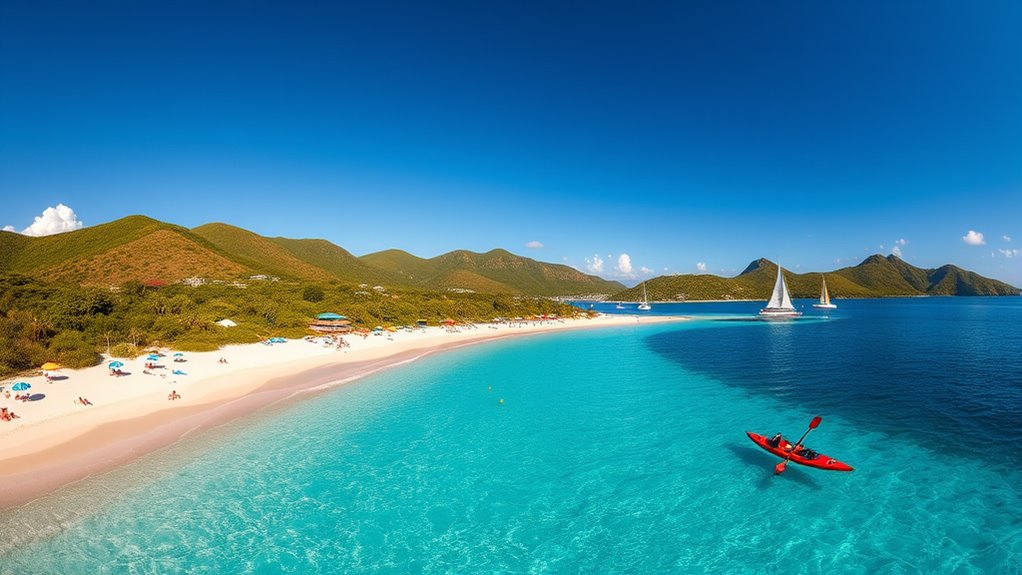
Timing your trip can notably affect your experience and budget, especially during peak season from December to April when prices are higher and crowds are larger. Off-peak months offer quieter beaches and better deals, but you should also consider the weather and hurricane risks from June to November. Planning ahead ensures you choose the best time for your priorities and enjoy a smoother trip.
Optimal Travel Timing
Planning your trip to the U.S. Virgin Islands requires choosing the right time for your visit. Peak season runs from December to April, when the weather is warm, sunny, and ideal for beach activities. Expect higher prices, busier beaches, and crowded attractions during this time. If you prefer fewer crowds and better deals, consider visiting during the off-peak months from May to November. Keep in mind, this is hurricane season, which can bring unpredictable weather and storms, especially between August and October. However, traveling during these months often means lower accommodation rates and a more relaxed atmosphere. Weigh your priorities—whether it’s perfect weather or quieter, more affordable experiences—to determine the best time for your trip.
Crowds and Pricing
Traveling during peak season, from December to April, means you’ll encounter lively crowds at beaches, popular attractions, and restaurants, along with higher prices for accommodations and activities. To save, consider booking well in advance, especially for beachfront villas and guided tours. Off-peak months, from May to November, offer fewer visitors and lower prices, but be mindful of the hurricane season. During these months, you might find better deals on hotels, car rentals, and dining, with a quieter, more relaxed atmosphere. Some attractions, like hiking trails and national parks, are less crowded year-round, making them ideal for off-peak visits. Whether you prefer bustling scenes or tranquil escapes, adjusting your travel dates can notably impact your experience and budget.
Weather and Hurricanes
The weather in the U.S. Virgin Islands is tropical, with warm temperatures year-round. From December to April, during the peak season, expect sunny skies, gentle breezes, and minimal rainfall—ideal for beach days and outdoor activities. However, this is also the most crowded and expensive time to visit. From June to November, the off-peak season, the islands experience higher humidity, more rain, and hurricane threats. While hurricanes are rare, they can disrupt travel plans, especially between August and October. If you’re planning a trip during this period, monitor weather forecasts and consider travel insurance. Traveling outside peak months can mean fewer crowds and better deals but be prepared for unpredictable weather and possible storm warnings.
Tips for Sustainable Tourism and Respecting Local Environment

Sustainable tourism is essential to preserving the natural beauty and vibrant culture of the U.S. Virgin Islands. As a visitor, your actions can help protect fragile ecosystems and respect local communities. Here are three tips to keep in mind:
- Respect wildlife and reefs: Avoid touching or disturbing animals and coral. Use eco-friendly snorkeling gear and stay within designated areas.
- Support local businesses: Choose locally owned restaurants, shops, and markets to help sustain the island’s economy and culture.
- Minimize waste: Carry reusable water bottles, bags, and containers. Dispose of trash responsibly, and avoid single-use plastics.
Essential Practical Information for Visitors

Traveling the U.S. Virgin Islands is straightforward, especially if you’re a U.S. citizen—no passport needed, and you can use your driver’s license for airport security. The islands have tropical weather year-round, so pack lightweight clothing, sun protection, and waterproof gear. Peak season runs from December to April, so expect higher prices and crowds; visiting during the shoulder months can save you money and avoid busy spots. Currency is U.S. dollars, and English is spoken everywhere, making communication easy. Renting a vehicle, especially a jeep, is the best way to explore, as public transport is limited. Keep safety in mind—be cautious of strong currents at beaches and stay updated on weather alerts, especially during hurricane season from June to November.
Frequently Asked Questions
Are U.S. Virgin Islands Visas Required for American Travelers?
You don’t need a visa to visit the U.S. Virgin Islands if you’re an American traveler. Since the islands are U.S. territories, U.S. citizens can travel there with just a valid ID or passport. You can enjoy the beaches, explore the islands, and experience local culture without worrying about visa requirements. Just make sure your identification is current, and you’re good to go for a smooth, hassle-free trip.
Can I Use My Cell Phone Without Extra Charges on the Islands?
You can usually use your cell phone on the islands without extra charges if your plan includes U.S. territories or has roaming enabled. Before you go, check with your provider to verify international or roaming options and possible fees. Consider purchasing a local SIM card or an international plan to avoid unexpected charges. Using Wi-Fi at hotels, cafes, or public spots can also help you stay connected without extra costs.
Are There Any Travel Restrictions or Safety Advisories Currently in Effect?
You should verify current travel restrictions and safety advisories before your trip. While the U.S. Virgin Islands generally maintain a safe environment, conditions can change due to weather or health concerns like COVID-19. Stay updated by visiting official government or travel websites. Follow local guidelines, such as mask mandates or safety protocols, and stay aware of weather alerts, especially during hurricane season, to ensure a smooth and safe visit.
What Are the Best Times to Avoid Crowds and High Prices?
Imagine the islands as a lively dance floor — December to April is the crowded, flashy salsa, with everyone wanting a turn. To dodge the crowd and save your wallet, plan your visit from late April to early June or September to November. Think of these times as the quiet, intimate waltz, where you can enjoy serene beaches and better deals without the tourist frenzy.
Is Travel Insurance Recommended for Trips to the USVI?
Travel insurance is highly recommended for your trip to the USVI. It can cover unexpected issues like trip cancellations, delays, or medical emergencies, especially since healthcare costs can be high abroad. Plus, it offers peace of mind if weather disruptions or hurricanes affect your plans. Whether you’re booking flights, accommodations, or activities, having insurance guarantees you’re protected against unforeseen events, making your trip more secure and stress-free.
Conclusion
Your journey through the U.S. Virgin Islands unveil a tapestry of vibrant cultures, breathtaking landscapes, and timeless traditions. Like the tide shaping the shore, your experiences will carve lasting memories and deepen your connection to this Caribbean paradise. Embrace each island’s unique spirit, respecting its delicate beauty as you go. In doing so, you’ll become a steward of its magic, ensuring these treasured horizons continue to inspire future explorers just as they’ve inspired you.

